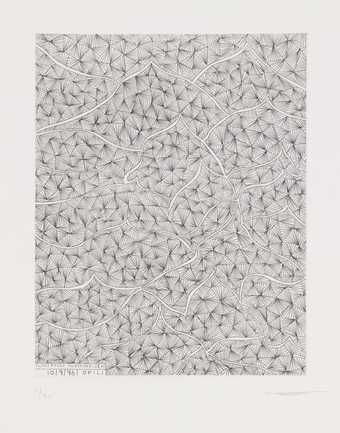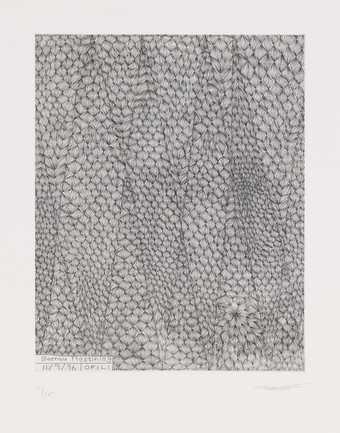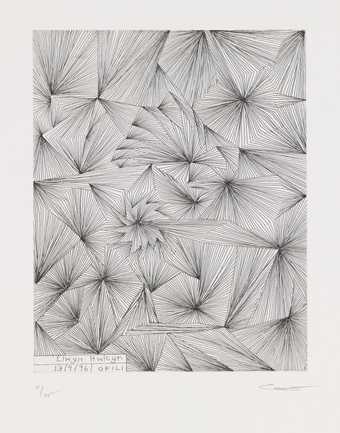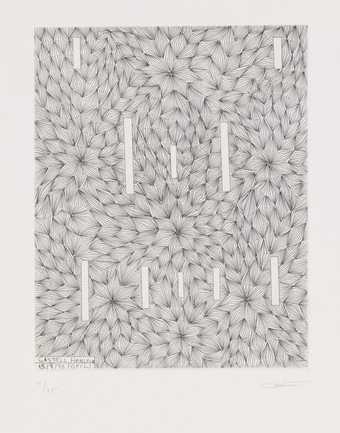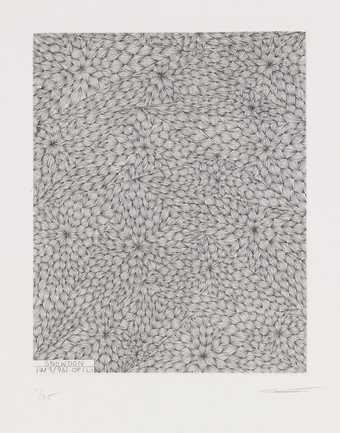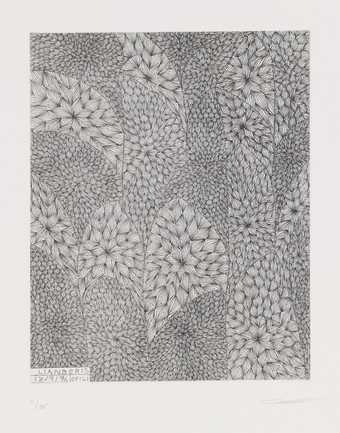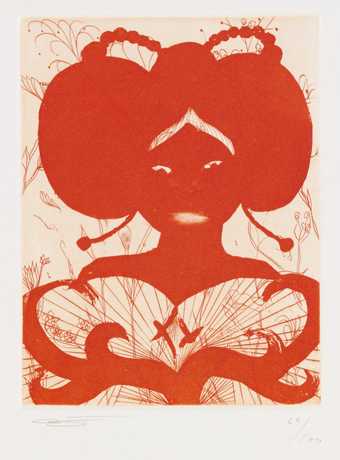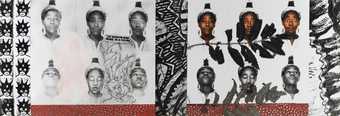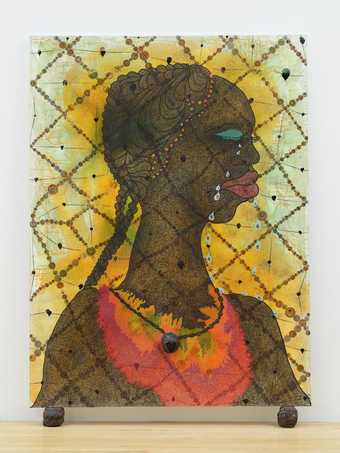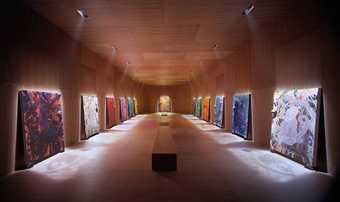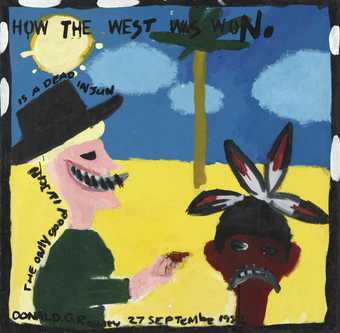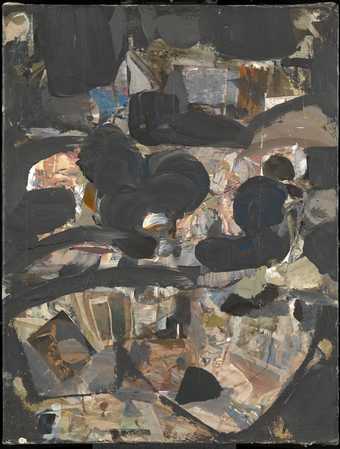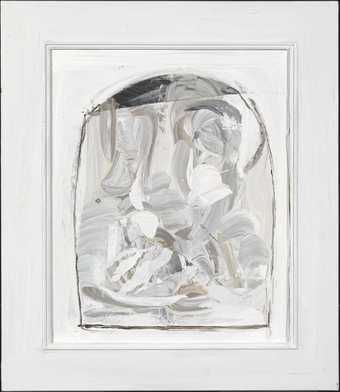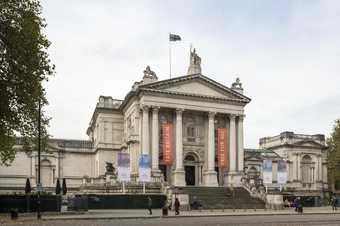
Not on display
- Artist
- Chris Ofili CBE born 1968
- Medium
- Oil paint, acrylic paint, printed paper, glitter, map pins, polyester resin and elephant dung on canvas
- Dimensions
- Support: 2440 × 1830 mm
- Collection
- Tate
- Acquisition
- Purchased with assistance from Evelyn, Lady Downshire's Trust Fund 1997
- Reference
- T07345
Summary
Double Captain Shit and the Legend of the Black Stars is a large painting by the British artist Chris Ofili that depicts Captain Shit, a black superhero invented by the artist. The figure of Captain Shit appears twice in this painting in identical overlapping representations. Both figures are presented frontally and stare out towards the viewer, and the figure at the front stands with his left hand on his hip. The two Captains are composed of very small dots of red and yellow paint and they wear skin-tight yellow suits and red capes, belts and boots. The suits are parted from the neck down to the waist, so that skin on the figures’ chests and stomachs is visible. The belts they wear have buckles made from lumps of elephant dung with the letters ‘CS’, standing for Captain Shit, written on them in red and yellow paint. There are two further balls of elephant dung in the upper part of the painting, positioned either side of the figures’ heads, and another two are placed under the bottom left and right corners of the painting. Surrounding the figures and visible behind the patches of red and yellow dots are a large number of black star shapes that are overlaid with photographs of eyes clipped from magazines. The background is creamy white in colour and much of the painting’s surface is covered with glitter, pins and resin.
Ofili produced this work in London in 1997. He had first begun to use elephant dung in his work following a research trip to Zimbabwe in 1992, when he became interested in the way that dung was used to trace the behaviour of wild animals. Ofili stated in 1999 that the inclusion of the dung was ‘a way of raising the paintings up from the ground and giving them a feeling that they’ve come from the earth rather than simply being hung on a wall’ (quoted in Carol Vogel, ‘Chris Ofili: British Artist Holds Fast to His Inspiration’, New York Times, 28 September 1999, http://partners.nytimes.com/library/arts/092899ofili-brooklyn-museum.html, accessed 24 October 2014). On that same trip to Zimbabwe the artist visited the Matobo Hills and saw ancient San cave paintings featuring small dots of paint on their surfaces, a technique that Ofili adopted thereafter and used in works such as Double Captain Shit and the Legend of the Black Stars.
The title of the work is reminiscent of the names of comic books, suggesting an adventure involving Captain Shit and the ‘black stars’ shown in the image. However, the word ‘legend’ and the phrase ‘black stars’ is also a reference to the achievements of real-life black people who were by that time celebrated as ‘superstars’. The curator Tanya Barson has described the stars in the painting as symbolic representations of ‘the many untold stories of fame in black history’ (Barson and Gorschlüter (eds.) 2010, p.22).
The character of Captain Shit was partly inspired by the Marvel Comics superhero Luke Cage, who first appeared in a comic in 1972. Cage was one of the earliest black superheros in American comic books and was the first to feature in a series bearing his own name. For Ofili, Cage was a symbol of the caricatured representations of black masculinity in popular culture during the 1970s, most notably in ‘blaxploitation’ films and funk and soul music. In 2009 the curator Okwui Enwezor stated that the iconography of the Captain Shit series ‘explores the black male as a kind of comic superhero, but one whose armours of masculinity and powers of persuasion lie in the ambivalent iconographies of the seventies funk music scene’ (Adjaye, Golden, Enwezor and others 2009, p.152).
Captain Shit has appeared in a number of Ofili’s paintings since 1996 and these are part of the artist’s ongoing exploration of the representation and reception of black culture across the world. For instance, in the 1998 work The Adoration of Captain Shit and the Legend of the Black Stars (Third Version) (Carnegie Museum of Art, Pittsburg), the superhero appears on a stage, surrounded again by ‘black stars’, and is being mobbed by adoring white fans who reach up to grab him. As the curator Judith Nesbitt has argued, in Ofili’s Captain Shit works ‘the paradox of contemporary black culture being avidly consumed by a white audience is wryly noted by Ofili and played back to his own audience’ (Nesbitt, Enwezor, Eshun and others 2010, p.15). Yet the Captain Shit paintings are also deliberately humorous, according to Ofili:
My project is not a PC [politically correct] project. That’s my direct link to blaxploitation. I’m trying to make things you can laugh at. It allows you to laugh about issues that are potentially serious.
(Quoted in Nesbitt, Enwezor, Eshun and others 2010, p.15.)
Further reading
David Adjaye, Thelma Golden, Okwui Enwezor and others, Chris Ofili, New York 2009, reproduced pp.95–7.
Tanya Barson and Peter Gorschlüter (eds.), Afro-Modern: Journeys through the Black Atlantic, London 2010, p.22, reproduced p.164.
Judith Nesbitt, Okwui Enwezor, Ekow Eshun and others, Chris Ofili, London 2010.
Fiona Anderson
October 2014
Supported by Christie’s.
Does this text contain inaccurate information or language that you feel we should improve or change? We would like to hear from you.
Display caption
Captain Shit is a superhero invented by Ofili, who has appeared in a number of his paintings since 1996. Partly inspired by the Marvel Comics character Luke Cage, Captain Shit is a symbol of black superstardom. The collaged black stars refer to the many untold stories of fame in black history. The distinctive surface of the painting was created by gradually building up layers of paint and resin, combined with paper cut-outs, glitter stars, map pins and elephant dung.
Gallery label, September 2008
Does this text contain inaccurate information or language that you feel we should improve or change? We would like to hear from you.
Technique and condition
The painting was executed on a single piece of coarse linen fabric, which is stretched extremely tightly around an eight-membered rigid strainer and attached with stainless steel staples along the rear edges. All joints in the softwood strainer are half- lapped and glued, and despite its apparent sturdy nature the cross members are significantly bowed out, due to the excessive tension in the canvas. For display the painting is placed on two lumps of elephant dung, which were sealed in a polyester resin by the artist in 1997, and is allowed to lean back against the wall. The linen fabric was supplied by Russell and Chapple and was purchased already primed with their Universal Primer (a styrene-acrylic copolymer emulsion product). The artist recalls that once attached to the strainer, the stretched face and tacking edges of the canvas were then covered with three coats of Lascaux Acrylic (pure acrylic) Gesso Primer as additional priming. Despite the many layers of ground, the overall thickness is still sufficiently thin for the canvas weave texture to remain apparent through it.
The first layer of paint was a very light yellow-green imprimatura, which was applied over the stretched face of the primed canvas. The image was then applied using a great variety of different materials. The actual paint used is thought to consist of oil and acrylic colour; the painted dots are probably oil and the black stars and light blue outlines are acrylic emulsion. Other materials used in the creation of this work were polyester resin, colour printed paper collage, glitter stars and spots, map pins and elephant's dung (sealed and dried). There are also numerous insects caught in polyester resin. The paint would have had a vehicular and paste-like consistency and most of it was probably applied straight from the tube. The order of application is quite clear. First the collaged elements were adhered to the surface, followed by the black stars, painted in acrylic. The map pins were inserted into the pieces of elephant's dung which were then stuck to the canvas with a Bosch hot glue gun. Then the surface of the painting was flooded with the polyester resin which bonded the pieces of dung in place. The glitter pieces were sprinkled into the resin before it dried. This stage must have been carried out with the painting horizontal, using a tipping technique to produce the runs of resin which reach all four edges. Once the resin had dried, the light blue outline was painted by brush and finally the coloured dots applied in oil. These could have been applied simply using the tube, or with a syringe, or dripping stick to position the dots carefully and control the amount of paint. Some of these dots, in particular the red ones, are exhibiting a small amount of wrinkling on their surfaces, a feature which is often seen in oil paint when it is applied so thickly.
The painting is currently in good condition. However, its behaviour in the long term is hard to predict with so many different materials being used. The weakest part of the structure is the dung pieces on the actual work, which will probably fall off at some point. It is also not known how well the pieces of dung are sealed in the polyester resin and for how long this will prolong their natural deterioration. The artist has left instructions should they ever need replacing. They do not need to be exact copies, but should be remade from dried elephant dung obtained from London Zoo.
Tom Learner
November 1997
Explore
- emotions, concepts and ideas(16,416)
-
- emotions and human qualities(5,345)
-
- heroism(29)
- formal qualities(12,454)
-
- cartoon / comic strip(177)
- repetition(391)
- universal concepts(6,387)
-
- irony(304)
- politics and society(2,337)
- miscellaneous(732)
-
- sequin(1)
- eye(269)
- black(796)
- dress: fantasy/fancy(506)
You might like
-
Chris Ofili CBE Twynitywod Morfa Harlech 10.9.96
1996 -
Chris Ofili CBE Blaenau Ffestiniog 11.9.96
1996 -
Chris Ofili CBE Llwyn Hwlcyn 13.9.96
1996 -
Chris Ofili CBE Castell Harlech 15.9.96
1996 -
Chris Ofili CBE Snowdon 17.9.96
1996 -
Chris Ofili CBE Llanberis 17.9.96
1996 -
Chris Ofili CBE [no title]
1999–2000 -
Chris Ofili CBE No Woman, No Cry
1998 -
Chris Ofili CBE The Upper Room
1999–2002 -
Donald Rodney How the West was Won
1982 -
Katy Moran Rooms of the Mind
2009 -
Katy Moran Lady Things
2009 -
Chris Ofili CBE Blue Devils
2014 -
Chris Ofili CBE Union Black
2003

